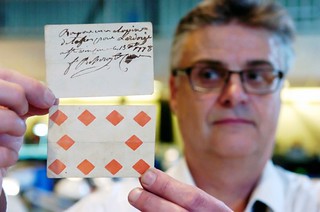
PREV ARTICLE
NEXT ARTICLE
FULL ISSUE
PREV FULL ISSUE
ARTICLE PROFILES CANADIAN COLLECTOR GEORGE MANZA short article in The Regina Leader-Post profiles Canadian collector
George Manz and highlights a some very rare Canadian numismatic items. -Editor
Avid coin collector George Manz points to two wellpreserved playing cards. On their face, they look like nothing more than a 10 of diamonds and a seven of clubs. "They're priceless," said Manz, manning his table at the Regina Coin Club's fall show on Sunday. That's because if you flip those cards over, there's some inky scrawl written on the back and a date, on the clubs, of 1778. The playing card money was a highlight of this weekend's show, said Manz, club president. At a time when hard currency could be in short supply, some enterprising merchant in what's now Quebec made his own with playing cards. It's believed one of the cards was good for the purchase of a bottle of rum, the other for a pint of rum. Manz, who often digs into the history books to learn more about his collection, said playing card money in what would become Canada began in the late 1600s when it was used to pay the troops in New France. The ships carrying real currency were sometimes delayed. The playing cards fit the bill until the real stuff arrived so the troops had spending money. Given the high illiteracy rates of the day, the cards were often cut in half or quarters to symbolize varying denominations. Manz bought his two cards at an auction in Toronto. He's since shown them to experts in Canada and the U.S. "They have never seen anything like these," Manz said proudly. "They're extremely rare." They weren't the only unique find on display. Ever hear of the Moose Jaw-based Bank of Saskatchewan? In this next-year country, a group of Moose Jaw businessmen believed in 1912 that it would be a going concern, so had proofs made for the money. They had to come up with $250,000 - which they hoped to raise through shares - to put in trust in order to get government approval. To boost the sale of shares, the wannabe bankers displayed proposed bank notes in several store windows on Main Street. But not enough people were buying. The displayed bank notes were optimistically dated May 1, 1913. "A lot of people lost money," said Manz, noting the shares sold for $100 a piece. Manz owns the only known tintype mirror proofs for the $20 Bank of Saskatchewan note that wasn't to be, while Gatewest Coin Ltd., of Winnipeg, had the approval proofs for the bills on display. "It was artwork back then," noted Gatewest employee Christopher Porco. The $10 bill has a beautifully detailed scene of railway construction, while the $20 bill shows the bustling Moose Jaw rail yards. In 1913, the aspiring bank project collapsed, and its fate was sealed the next year. "World War 1 came and wiped everyone out," he noted. In 1935, currency was standardized - all issued by the Bank of Canada. To read the complete article, see:
Wayne Homren, Editor The Numismatic Bibliomania Society is a non-profit organization promoting numismatic literature. See our web site at coinbooks.org. To submit items for publication in The E-Sylum, write to the Editor at this address: whomren@gmail.com To subscribe go to: https://my.binhost.com/lists/listinfo/esylum All Rights Reserved. NBS Home Page Contact the NBS webmaster 
|
